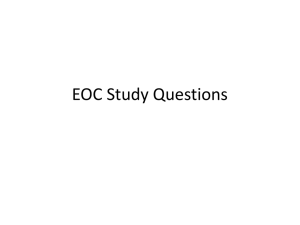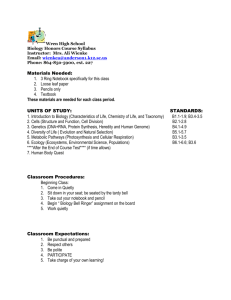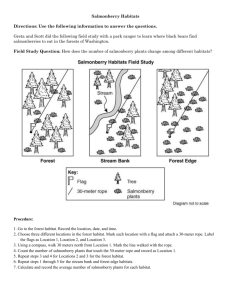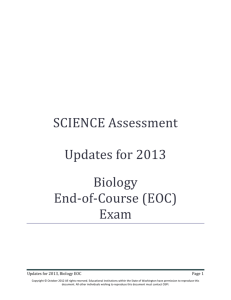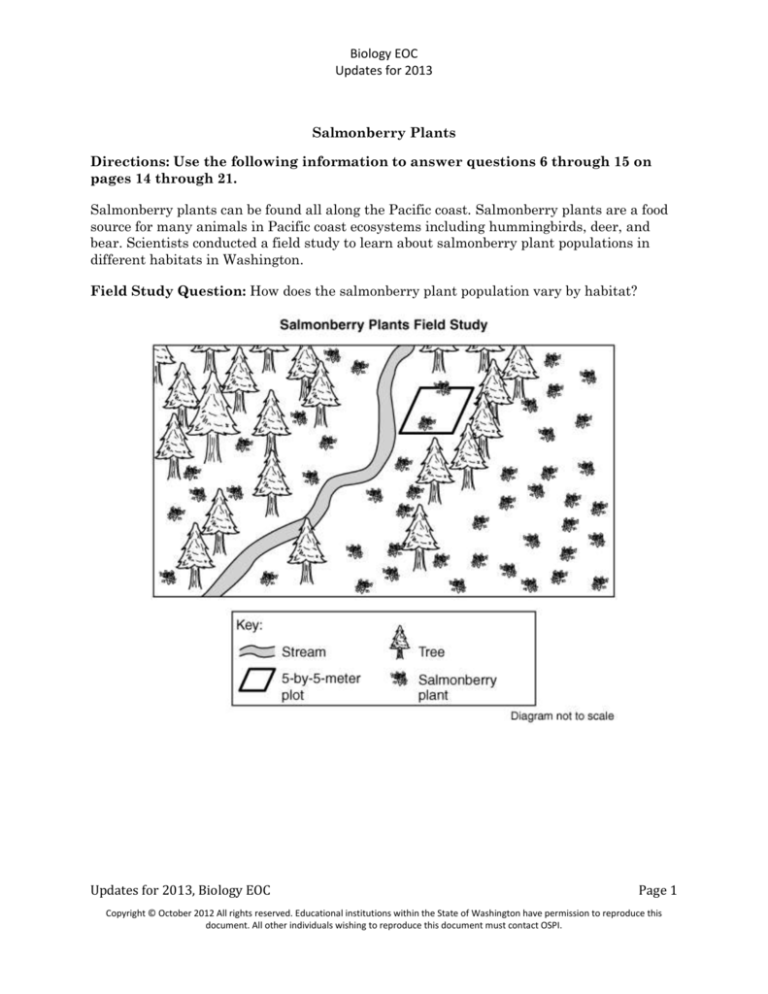
Biology EOC
Updates for 2013
Salmonberry Plants
Directions: Use the following information to answer questions 6 through 15 on
pages 14 through 21.
Salmonberry plants can be found all along the Pacific coast. Salmonberry plants are a food
source for many animals in Pacific coast ecosystems including hummingbirds, deer, and
bear. Scientists conducted a field study to learn about salmonberry plant populations in
different habitats in Washington.
Field Study Question: How does the salmonberry plant population vary by habitat?
Updates for 2013, Biology EOC
Page 1
Copyright © October 2012 All rights reserved. Educational institutions within the State of Washington have permission to reproduce this
document. All other individuals wishing to reproduce this document must contact OSPI.
Biology EOC
Updates for 2013
Procedure:
1. Go to the salmonberry field study area. Record location, date, time, and temperature.
2. Choose a random location in the forest edge habitat.
3. Measure a 5-meter-by-5-meter plot and label as Plot 1.
4. Count the number of salmonberry plants in Plot 1. Record as Plot 1 for the forest
edge habitat.
5. Repeat steps 2 through 4 for Plot 2 and Plot 3, choosing a new location in the forest edge
habitat for each plot.
6. Repeat steps 1 through 5 for the stream bank and forest habitats.
7. Calculate and record the average number of salmonberry plants for each habitat.
Data Collected:
Location: Forest edge, stream bank, and forest habitats
Date and Time: May 1, from 11:00 A.M. to 2:00 P.M.
Temperature: 10° C to 15° C
Updates for 2013, Biology EOC
Page 2
Copyright © October 2012 All rights reserved. Educational institutions within the State of Washington have permission to reproduce this
document. All other individuals wishing to reproduce this document must contact OSPI.
Biology EOC
Updates for 2013
Plan a field study to answer the question in the box. You may use any materials and
equipment in your procedure.
Be sure your procedure includes:
logical steps to do the field study
conditions to be compared
data to be collected
method for collecting data
how often measurements should be taken
and recorded
environmental conditions to
be recorded
Field Study Question: How does the total rainfall in different years affect
the mass of berries produced by a salmonberry plant?
Procedure:
Updates for 2013, Biology EOC
Page 3
Copyright © October 2012 All rights reserved. Educational institutions within the State of Washington have permission to reproduce this
document. All other individuals wishing to reproduce this document must contact OSPI.
Biology EOC
Updates for 2013
Scoring Rubric for Salmonberry Plants New Field Study (page 1 of 3)
Performance Description
A 2-point response demonstrates the student understands the Content Standard
INQB: Scientific progress requires the use of various methods appropriate for
answering different kinds of research questions, a thoughtful plan for gathering
data needed to answer the question, and care in collecting, analyzing, and
displaying data. Item Specification 2: Describe a plan to answer a given
question for a field study.
A 1-point response demonstrates the student has partial understanding of the
Content Standard.
A 0-point response demonstrates the student has little to no understanding of
the Content Standard.
Updates for 2013, Biology EOC
Attributes
6–7
3–5
0–2
Page 4
Copyright © All rights reserved. Educational institutions within the State of Washington have permission to reproduce this document. All other
individuals wishing to reproduce this document must contact OSPI.
Biology EOC
Updates for 2013
Scoring Rubric for Salmonberry Plants New Field Study (page 2 of 3)
Attributes of a Procedure for a Field Study
Attribute Name
Method for Collecting
Data
(Controlled Variable)
Conditions to be
Compared (Independent/
manipulated Variable)
Data to be Collected
(Dependent/ responding
Variable)
Record Measurements
Observations are
Repeated
Record
Environmental
Conditions
Logical Steps
Description
Attribute
The procedure states or implies a consistent sampling
strategy or technique (e.g., keeps the sampling area the
same, count at the same time every day).
1
Only one independent variable (total rainfall) is identified or
implied in the procedure or data table (if given). The
independent variable must have at least three conditions to
be credited.
1
The data collected to answer the field study question (mass
of berries) is identified or implied in the procedure or data
table (if given).
The procedure states or implies measurements are recorded
periodically or gives a data table.
Attribute Notes:
1. If artificial data for the responding variable is given, this
attribute cannot be credited.
2. The phrase take measurement cannot be used to mean
record.
More than one observation for all conditions is planned, or
implied in a data table, (e.g., Go to the same plants every
year, Repeat steps 4-5 for the same plants.)
Procedure identifies or implies recorded observations of at
least one local environmental condition that might have an
effect on the focus variables (e.g., record air temperature,
date)
The steps of the procedure are detailed enough to repeat the
procedure effectively (examples of illogical steps: no ending
time indicated, no limitation to the sampling area is given,
recording vague data or results).
Total Possible Attributes
Updates for 2013, Biology EOC
1
1
1
1
1
7
Page 5
Copyright © All rights reserved. Educational institutions within the State of Washington have permission to reproduce this document. All other
individuals wishing to reproduce this document must contact OSPI.
Biology EOC
Updates for 2013
Scoring Rubric for Salmonberry Plants New Field Study (page 3 of 3)
General Notes:
1. Inappropriate Procedures: If the response does not plan an appropriate procedure for the given
question, the response may not earn any of the possible attributes.
Examples:
a) Repeats the procedure from the scenario
b) Measures only one condition (therefore cannot establish the controlled or manipulated variables)
c) Purposefully changes more than one variable simultaneously.
d) Writes a procedure that is too vague to possibly be appropriate
e) Writes a prediction instead of a procedure
2. Naming Attributes: If the response names a bulleted attribute listed after “Be sure your procedure
includes:” without including that attribute in the procedure, the attribute cannot be credited. When a
bulleted attribute is named and implied in the response, both must be correct to be credited.
3. Clarifying Vagueness in Procedures:
a) Measuring a vague parameter (e.g., observe the berries instead of mass) may be credited as an
independent/manipulated or dependent/responding variable. However, a vague parameter is difficult
to repeatedly measure, so the logical steps attributes cannot be credited.
b) The term “repeat” at the end of a step refers to that step only.
c) The term “repeat” as a separate step (or in a new paragraph) refers to the whole procedure.
d) The term “repeat,” when qualified, cannot be credited for multiple trials (e.g., repeat if necessary,
repeat as desired).
e) A vague action that calls for the independent/manipulated variable to be changed (e.g., change
habitat) without indicating how many times, gives no end to the investigation so the logical steps
attribute cannot be credited.
f) At high school, a vague action that calls for the independent/manipulated variable to be changed
without indicating how many times cannot be credited for more than two conditions of the
independent/manipulated variable
Updates for 2013, Biology EOC
Page 6
Copyright © All rights reserved. Educational institutions within the State of Washington have permission to reproduce this document. All other
individuals wishing to reproduce this document must contact OSPI.
Biology EOC
Updates for 2013
Student Responses
Response A- 7 attributes
1. Go to a salmonberry habitat that gets 250 cm rainfall a year.
Record the location, date, time, and temperature.
2. Mark a 5 by 5 m plot.
3. Pick the berrys off all the plants in the plot and record the total mass of
the berrys.
4. Repeat steps 1-3 in a salmonberry habitat that gets 500 cm rainfall.
5. Repeat steps 1-3 in a salmonberry habitat that gets 750 cm.
6. Repeat steps 1-5 for two more years on the same date, time, and at the
same locations.
7. Calculate the average mass of berrys for each location.
Response B- 4 attributes
1.
2.
3.
4.
Go to the forest habitat. Record weather.
Pick 100 berries off a plant. Mass the berries.
Find the total rain.
Go to the forest for two more years and do the same thing.
Response C- 3 attributes
Find a plant that grows in a place with 3 foot of rainfall. Find an
other that grows in a place with 2 foot of rainfall and an other
that grows in a place with 1 foot of rainfall. Find the amount
of berries on each plant. Repete
Response D- 0 attributes
1. Plant three salmonberry plants in the same size pots.
2. Give one plant no light, the second plant 3 hours of light a day, and the
third plant 10 hours of light a day.
3. After 2 weeks, count the number of salmonberries on each plant and
record.
4. Repeat steps 1-3 two times using a new set of plants each time.
Updates for 2013, Biology EOC
Page 7
Copyright © All rights reserved. Educational institutions within the State of Washington have permission to reproduce this document. All other
individuals wishing to reproduce this document must contact OSPI.
Biology EOC
Updates for 2013
Response E
The samonberry plants that grow in places with the most rainfall will have
berries with the most mass because there will be lots of water in the soil for
the roots to soak up and it will go into the berries and make them plum and
juicey and heavy.
Response F
1)Go to a place that has salmonberry plants and gets
100 in. of rain per year. Record the environmental conditions.
2)Find a plant and pick off 5 berries. Find the total mass of the berries.
3) Repeat steps 1-2 in places that get 200 of rain.
4) Repeat steps 1-3 each month.
Response G
1. Go to the library and determine three salmonberry habitats that get 35
inches, 45 inches, and 55 inches of rainfall.
2. Go to the 35 inch area. Record location, date and wether.
3. Choose a random location in the area.
4. Measure a 5-meter-by-5-meter plot and label as Plot 1.
5. Record the mass of the salmonberries
6. Repeat steps 3 through 5 for Plot 2 and Plot 3.
7. Repeat steps 2 through 6 for the 45 inch and 55 inch areas.
8. Calculate and record the average mass of salmonberries for each rainfall
area.
Updates for 2013, Biology EOC
Page 8
Copyright © All rights reserved. Educational institutions within the State of Washington have permission to reproduce this document. All other
individuals wishing to reproduce this document must contact OSPI.
Biology EOC
Updates for 2013
Response H
Controlled variables: day and location
Manipulated variable: total mass of berries on a bush
Responding variable: inches of rainfall
1) Find field study locations that get 10 meters, 20 meters and 30 meters of
rain fall. Record the date .
2) Find a bush in each location, and write down the total mass of all the
berries on each bush.
3) Repeat steps 1 and 2 for three more years at the same locations, same
bushes, and same day of the year.
Response I
a. Go to the forest edge and choose and tag 15 salmonberry plants
b. Record the rainfall for the last year (look up the data on the internet)
c. Label each plant 1-15 and then mass all the berries on each plant and
record.
d. Return the next year and look up the rainfall information again.
e. Use the same 1-15 plants and record the mass of the berries for each.
f. Repeat steps d-e for 2 more years.
g. Calculate and record the effect of rainfall on the mass of berries
produced over the last 4 years.
Response J
1.
2.
3.
4.
Go to the salmonberry area. Record location, date, time, and temperature.
Choose a location in the forest edge habitat.
Measure a 5-meter-by-5-meter plot and label as Plot 1.
Count the number of salmonberry plants in Plot 1. Record as Plot 1 for the
forest edge habitat.
5. Repeat steps 2 through 4 for Plot 2 and Plot 3, choosing a new location in
the forest edge habitat for each.
6. Repeat steps 1 through 5 for the stream and forest habitats.
7. Calculate and record the averages.
Updates for 2013, Biology EOC
Page 9
Copyright © All rights reserved. Educational institutions within the State of Washington have permission to reproduce this document. All other
individuals wishing to reproduce this document must contact OSPI.

